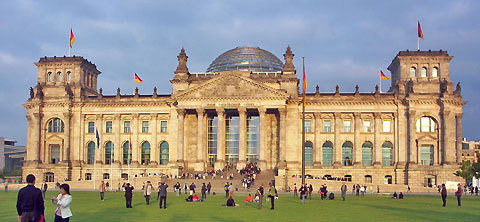HIS 102
Unit 12: Fascism

The
German
Reichstag. The original building, which opened in 1894, functioned
as the parliament of the German Empire (before World War I) and then
the Weimar republic in Germany after 1918. Shortly after Hitler legally became chancellor of
Germany (30 January 1933) the Reichstag burned "to the ground" (27
February 1933). Conflicting evidence points to the Nazis as the culprits
behind the fire, but in any case, the fire provided the pretext for
Hitler and the Nazis to blame communist insurgents and then to suspend
constitutional rights and embark on a dictatorship. Soon thereafter,
23 March 1933 the Reichstag passed the Enabling Act which essentially gave
Hitler dictatorial powers. The
building was heavily damaged by the Red Army during the battle for
Berlin in April 1945, and after the war the Reichstag remained basically a ruin in
the Western sector of Berlin. It was never completely demolished, and
in the early 1960s reconstruction took place. As a symbol of German unity, the
official German reunification ceremony took place in the Reichstag on 3 October 1990. In the
late 1990s the building was completely gutted and rebuilt once again. The seat of
parliament returned to the Reichstag in April 1999. Photo courtesy Colocho at Wikipedia Commons
 What you must do in this unit
What you can do in this unit
What you must do in this unit
What you can do in this unit
- Listen to some further information about this unit
as a mp3 file. You can also read the information as
a txt file.
Some videos that you can watch for this unit
Extra Credit Options
- For a maximum of 50 points extra credit, write a short paper of one or two pages, Who was more prescient in their views of
modern society, Franz Kafka or José Ortega y Gasset? Please be sure to cite your sources.
- There
were other intellectuals who offered unusual interpretations of the
modern world. For a maximum of 50 points, write a short paper in
which you comment upon their views. Please be sure to cite your
sources--You are not limited to these excerpts:
- For a maximum of 50 points extra credit, write a one-page paper (maybe
two pages if they are exceptional) that provides a detailed comparison of
Hitler's ideas on national socialism and Benito Mussolini's
What Is Fascism?
- Be Brave! For a maximum of 50 points extra credit, read Benito Mussolini (1883-1945): The Doctrine of Fascism?,
1932 and write a one-page paper explaining the main points of fascism as understood by Mussolini.
- Watch Leni Riefenstahl's documentary film Triumph des Willens (Triumph of the Will) and
answer the movie
study questions for a maximum of 25 points extra credit. Please write in formal, complete sentences.
- For a maximum of 10 points extra credit, answer the Hitler
study sheet
questions.
- For extra credit, please suggest a
relevant website for this unit of the course. Send the title of the site, the url and a
brief explanation why you find the information interesting and applicable to
the material being studied this unit.
|

